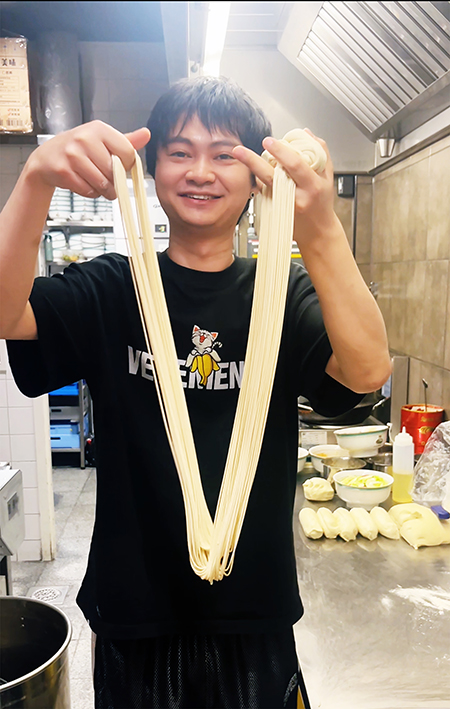
Zhou Yan tries his hand at pulling noodles at Ox Lan in Stockholm, Sweden, in May 2024. [Photo/CHINA DAILY]
Amid the savory aroma of simmering beef broth and the rhythmic movements of a noodle-pulling chef, Ox Lan attracts a lively crowd.
But this bustling restaurant isn't hidden in a Chinese city — it's in Stockholm, the capital of Sweden, where a traditional Lanzhou delicacy has unexpectedly become a culinary sensation.
Founded by Zhou Yan, a 32-year-old native of Gansu province in Northwest China, Ox Lan is more than just a business — it's a heartfelt mission to bring a centuries-old Chinese tradition to the world.
"As a devoted lover of beef hand-pulled noodles, I feel compelled to share the culinary heritage of my hometown, which dates back to 1915, with a wider audience," Zhou said.
The idea took root during a 2023 trip to Stockholm, where Zhou noticed something missing from the city's otherwise vibrant Asian food scene: while Japanese ramen and Vietnamese pho were easy to find, authentic Chinese noodles were noticeably absent.
Zhou saw an opportunity to introduce Swedes — already familiar with broth-based dishes — to Lanzhou beef noodles.
"I've always found it curious that KFC and McDonald's are everywhere, yet there are no major Chinese fast-food chains abroad," Zhou explained. "My dream is to make Chinese fast food — like beef noodles — just as popular and widespread."
Zhou quickly began making thorough preparations. He studied local business regulations, hired an experienced noodle-pulling chef, secured a location, and eventually opened Sweden's first Lanzhou beef noodles restaurant.
The response was immediate and enthusiastic. Since opening, Ox Lan has seen a steady stream of patrons — 70 percent of them Swedish.
"Customers are captivated by the artistry of hand-pulled noodles," Zhou said. "They're used to ramen and pho, which are often pre-made. Watching dough transform into noodles in front of them is a whole new experience."
Another unique feature that fascinates local customers is the option to choose the width of the noodles.
Zhou offers seven variations, from a delicate 0.5 mm to a robust 50 mm strand. "In Lanzhou, the most popular choice is erxi — the fourth thinnest — for its perfect balance of texture and bite," he said. "But in Sweden, there isn't a favorite yet. People are open to trying all seven options."
Cultural phenomenon
The noodle-making process has also become a hit on social media. Local influencers frequently post videos of the mesmerizing hand-pulling process, turning the restaurant into an unexpected cultural ambassador.
"Some content creators even research Lanzhou's history and share it with their followers," Zhou noted. "It's a beautiful form of cultural exchange."
But Zhou's dedication goes beyond visual spectacle. Each bowl at Ox Lan strictly follows the traditional "five elements" of Lanzhou beef noodles: crystal-clear broth, white radish slices, chili oil, green garlic sprouts, and golden wheat noodles.
Of these, Zhou pays particular attention to the broth, which simmers for five to eight hours each day. It combines 50 kilograms of beef and marrow-rich ox bones with 20 carefully chosen spices including star anise, clove, and pepper.
To ensure consistency, Zhou personally tastes each batch every morning. He believes the soul of Lanzhou beef noodles lies in the subtle interplay of spice and noodle width.
"The spices add depth to the broth without overwhelming its natural flavor," he said. "That's what gives the soup its clear appearance yet rich taste."
This delicate balance has captivated generations of Lanzhou residents. "Each shop in Lanzhou offers a slightly different experience," Zhou explained. "Choosing your preferred noodle width and savoring the broth is part of the joy."
According to Zhou, Lanzhou, a city of four million people, is home to an estimated 2,000 to 3,000 beef noodle shops, with roughly half the population enjoying a bowl every day. "Here, beef noodles aren't just food — they're a cultural icon," he said.
Zhou is now planning to launch more locations around the world, with three new spots already in the works in Spain. "I want to introduce Chinese fast food to more major European cities," he said. "France and Italy are next on my list."
 Editor:邱小宸
Editor:邱小宸